Should My Dachshund Wear a Collar or Harness for Walking?
The most essential accessory for your Dachshund is something to attach their leash to while you’re out walking, whether it be a collar or harness.
A standard collar is normally the “default” option for most dog owners.
However, in my opinion, Dachshunds should be walked using a harness. Here’s why.
UPDATED: March 9, 2023
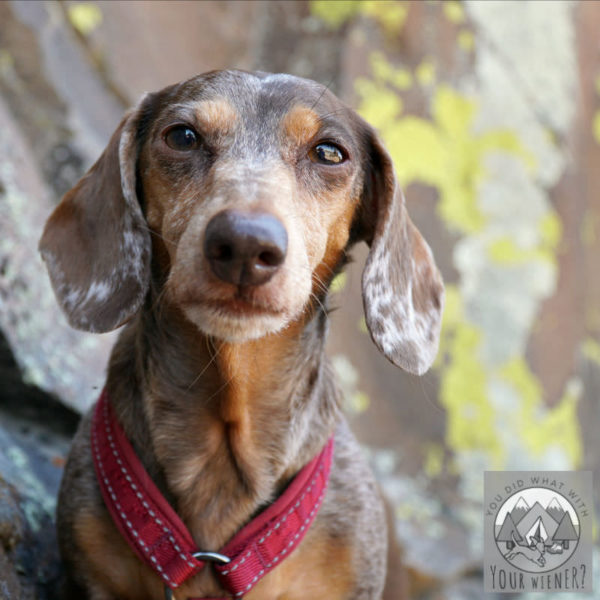
Harness vs Collar: Why a Harness is Safer for Dachshunds
Has your Dachshund ever started coughing or “honking” after being pulled on their collar?
Those noises are the product of your dog’s airway being restricted.
Has your Dachshund ever tried to run after a squirrel and been abruptly stopped by their collar?
That scenario puts a lot of stress on their neck and back.
When my first Dachshund was younger, I used a collar to walk him so I’ve experienced both of those things first-hand.
One time, Chester took off after something only to be yanked back by his collar, causing him to fall down and scrape the side of his face.
That wasn’t my proudest Dog Mom moment.
Both of the situations above can lead to serious injury.
Dachshunds are prone to back and neck problems, such as Intervertebral Disc Disease (IVDD), and tracheal collapse (like most small dogs).
Some experts warn that walking your Dachshund using a collar can put direct pressure on their trachea and vertebrae in the neck, which can cause a “cascading effect” and put pressure on other disks in the spine.
Others argue that there is no direct correlation between collar use compared to harness use and an increased risk of IVDD.
But all studies that I have read agree that the strain on the neck caused by a collar when a dog pulls or lunges can cause significant injuries to the neck, esophagus, larynx, and trachea.
This is true regardless of the collar type, including padded collars.
They can also cause eye damage by increasing intraocular pressure, compress blood vessels, and restrict a dog’s ability to breathe properly.
If your dog is wearing a harness, their trachea and spine is unlikely to be affected negatively when they start running or pulling.
But they are still at risk of injury if the harness isn’t properly fitted.
An improperly fitted harness could cause a chest injury if your Dachshund pulls hard or jerks the leash chasing after a squirrel.
They can also cause discomfort from rubbing or chafing around the legs.
While the experts are divided about the connection between the use of a collar and IVDD risk, I believe it’s better to err on the side of caution.
A properly fitting harness is the safest option.
Pros of Using a Harness for Your Dachshund
Besides the safety reasons above, which is really all the convincing you should need, there are other reasons to walk your Dachshund using a harness instead of a collar too.
- Better control of your dog, especially when in crowded or chaotic situations.
- Helps stop your Dachshund from jumping on people, other dogs or wildlife.
- Discourages pulling. With a collar, your dog may get an extra step in while pulling. This action is much more difficult with a harness.
- Keeps your dog from getting tangled in a collar and leash combination.
- If your Dachshund is easily distracted, a harness will help keep them safe and secure in environments with over-stimulation.
- It’s less unlikely that a harness will accidentally come off your dog. Collars can slip over your Dachshund’s head. They also pose the risk of coming undone if your dog pulls with enough force.
Cons of Using a Harness for Your Dachshund
With any tool, there are both pros and cons to consider. This includes the use of a harness when walking your Dachshund.
Here are a few points that you should consider to make an informed decision for your dog.
- Can be more difficult to put on, depending on the design
- Some dogs are encouraged to pull more with the leash hooked to the back
- May not have a place for an ID tag on the harness
- Harnesses that sit across the front of the shoulders can restrict movement and negatively impact your dog’s gait
- May be bulky uncomfortable, especially in hotter weather
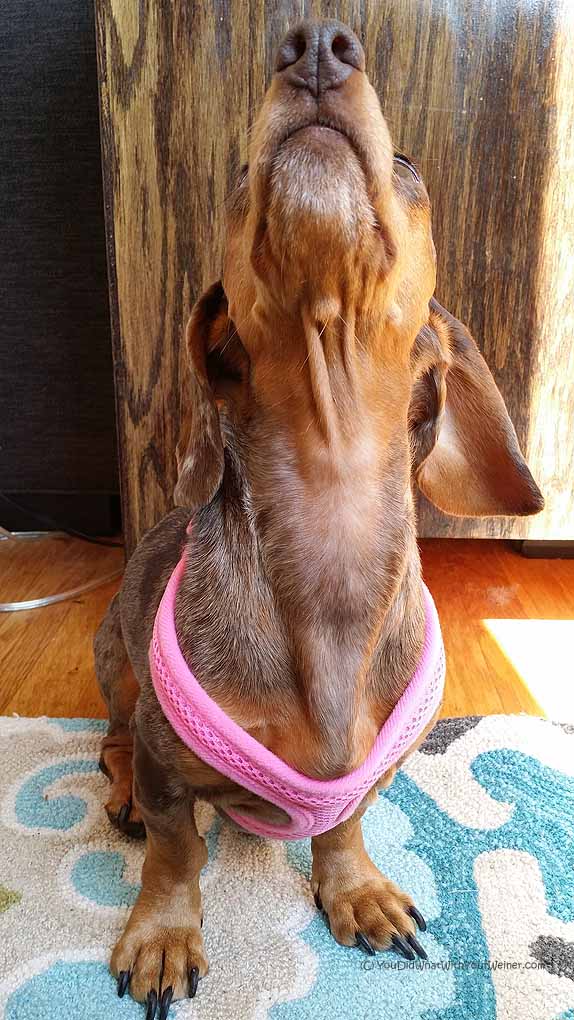
Harness Use and Gait Restriction
The most significant debate against using harnesses is that the design of some harnesses can restrict shoulder extension when a dog is walking.
No-pull harnesses, also known as restrictive harnesses, are the biggest offender.
They’re designed to sit across the front of the dog’s shoulder and limit movement in that area to prevent a dog from pulling forward.
A restricted gate can lead to long-term repetitive strain injuries and other potential mobility complications.
When choosing a harness, try it on your Dachshund and pay careful attention to the range of movement in the shoulder area.
The harness should allow them to walk freely without any restrictions.
How to Choose a Harness for Your Dachshund
Harnesses are available in a few different styles but the best once distribute the weight across your Dachshund’s chest.
Harnesses that distribute pressure to the chest instead of neck usually look low-slung across the front of their chest (think boat neck shirt) or have a V-neck design.
Take these steps to choose the right harness for your Dachshund:
Find a style you like
Find a harness design and style that you and your dog like.
Your dog steps into some harnesses while some are slipped over the head and clipped.
Some use buckles as for fasteners and some use Velcro.
Some are made of narrow webbing while some fit like a vest or have a wide chest plate.
For Dachshunds, who are short, a harness where you attached the leash at the back is most likely the best option.
Are there extra features?
Take extra features into consideration.
Some harnesses are outfitted with reflective trim, ID tag pockets, a handle and multiple points of adjustment.
Purchasing a harness with these extras comes down to preference.
Choose the right material
Harnesses are most commonly made out of nylon webbing, nylon mesh, cotton fabric, or leather.
Choose the right one for your dog based on comfort, required maintenance (like oiling leather), and preference.
If you plan to hike or walk long distances with your Dachshund, consider buying a harness with breathable padding for extra comfort.
Choose the right fit
Take thorough measurements of your dog and compare it to the size chart to find the size that will fit your dog.
You’ll want to measure the widest part of your Dachshund’s ribcage, just behind the front legs, and the neck circumference.
Some brands will include a chart that shows how to measure your dog for their specific harness style.
It’s not uncommon for a Dachshund to be in-between sizes.
While some harnesses are highly adjustable and have a wide margin of error, some, like the harness pictured below, are not adjustable and must fit perfectly.
If your dog is in-between sizes in two different harnesses, and one is adjustable, it’s probably safest to go with the adjustable one.
Before taking your Dachshund out in their new harness, try it on at home. Check to make sure that it fits properly and doesn’t restrict their movement in any way.
Which Harnesses Do You Recommend for Dachshunds?
Disclosure: Some of the links below are affiliate links. That means that I get a small commission if you purchase a qualifying product.
Harnesses are such an individual decision.
Each person has their preference and each dog has their own unique, size, shape and needs.
However, there are a few harnesses I’ve tried for my Dachshunds over the years that stood out.
VelPro Choke Free Mesh Harness
The VelPro Choke Free Mesh Harness has been our everyday go-to harness for years.
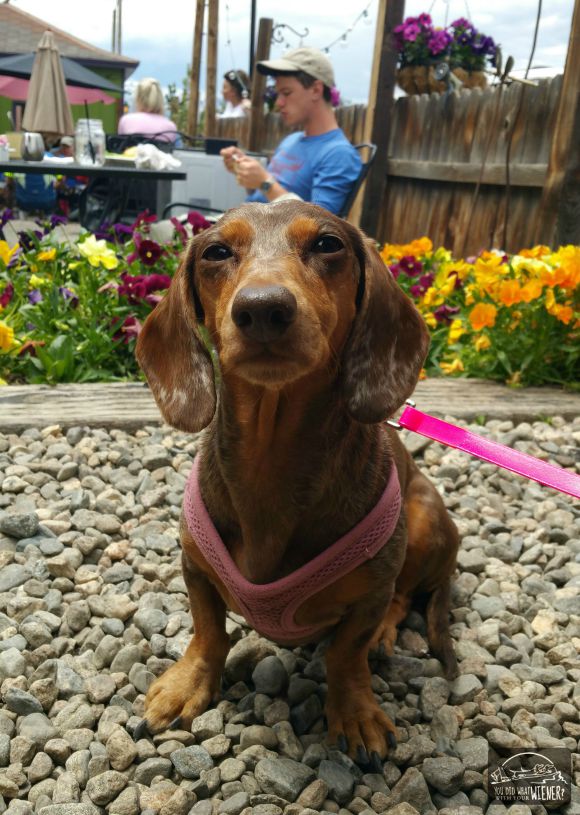
It’s comfortable for my Dachshunds to wear because it’s soft and breathable.
My dogs regularly wear it 24 hours a day, a few days in a row, when we travel. They are not uncomfortable in it nor have they developed any abrasions or sore spots.
Gretel wore hers for almost 10 weeks straight when she suffered an IVDD-related back injury and had to be on strict crate rest.
I love that it puts all of the pressure on a Dachshund’s chest bone instead of neck.
You can read more about why it’s our favorite harness HERE.
Hurtta Casual Padded Y Harness
The Hurtta Padded Y Harness is a more traditional-style harness but it has a V neck so it still distributes most of the pressure on a Dachshund’s breast bone.
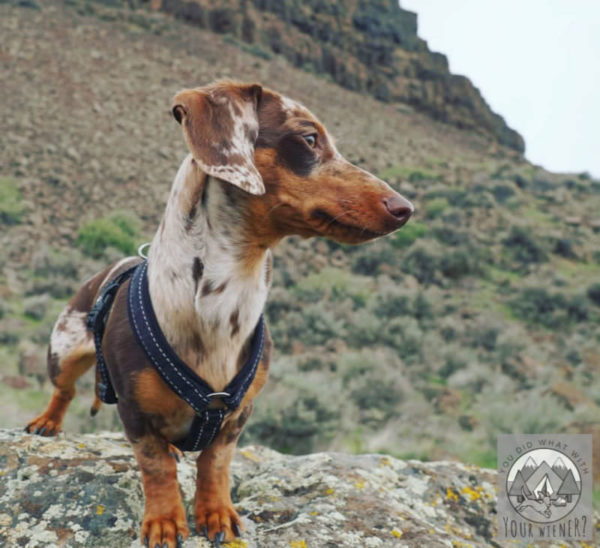
It also has neoprene padding on the inside of the harness webbing for comfort.
We use this harness any time we’ll be hiking or walking for over 3 miles or when it may get wet or dirty from rainy streets or muddy trails.
I had a really hard time finding a harness that didn’t chafe my Dachshund’s arm pits or elbows.
Gretel has hiked over 10 miles in this harness, through streams and mud, and never developed a raw spot.
You can read more about why it’s our favorite harness for when we’re hiking or walking long distances HERE.
Dachshund Delights Mesh Hug-A-Dog Harness®
Although we don’t currently use any other harnesses besides the two above, the Hug-A-Dog Harness® would be one of my top choices if we did.
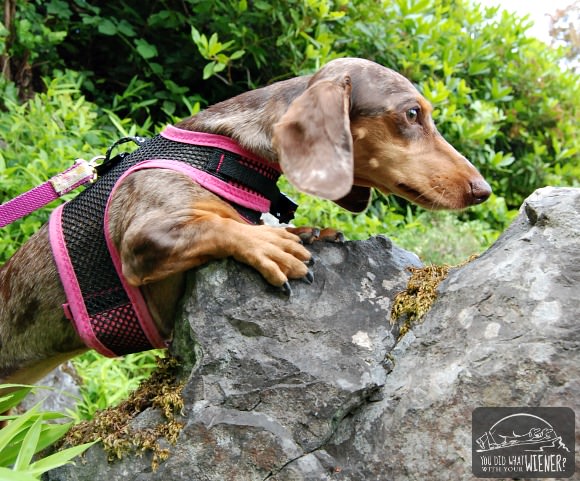
The #1 selling point for this vest-style harness is that it’s almost impossible for a Dachshund to get out of.
This harness also stands out because it’s made to fit a Dachshund’s body and comes in 1/2 inch size increments so you can almost get a custom fit for your pup.
I also like it because the mesh version of this harness is very lightweight and extremely breathable.
While it’s been a few years since I’ve used it for the dogs, and we only walked a couple of miles in it, I don’t remember any chafing issues.
However, do be aware that it can put a bit of pressure on your dog’s throat if they pull on the leash a lot (but not as much as a collar because the wider strap distributes the pressure more evenly).
If you have a dog that is constantly straining against the end of the leash, this may not be the harness for them.
Should I Throw Out My Dog’s Collar?
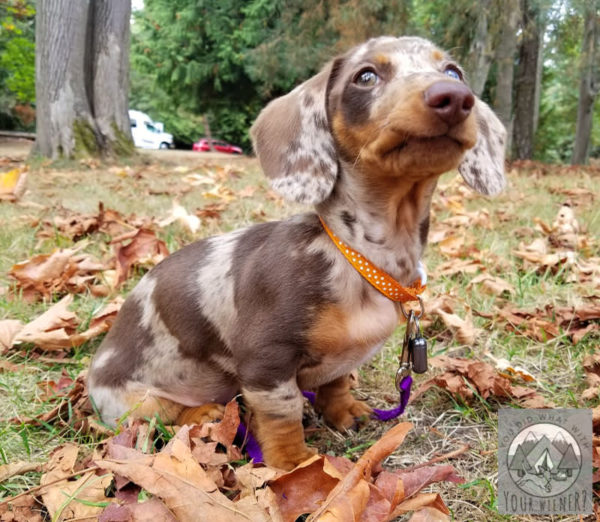
Although you’ll want to walk your Dachshund using a harness, you probably want to keep at least one collar on hand.
It’s important for your dog to wear a collar with ID when they don’t have their harness on.
If your dog gets lost without a collar on, they could easily be mistaken for a stray.
Alternately, some people keep the collar with ID on all the time instead of switching their dog’s ID back and forth between the collar and harness.
They just put the harness on in addition when needed.
Either way, make sure your Dachshund’s ID tags are always up to date with your current phone number and address.
Final Thoughts
While choosing to walk your Dachshund on a collar or harness is a personal preference, hopefully I’ve given you good reason to go with a harness as your first choice.
However, not all harnesses are created equal.
If you use one that restricts your dog’s natural gait, you may be doing more harm than good when it comes to increasing the risk of orthopedic injury.
And, remember, even if you use a harness for walking your dog, you will still want to keep a collar on hand.
There may be times you need it like attaching ID to your dog when they’re not wearing their harness or during an exam that requires the vet get an unobstructed view of your dog’s back and shoulders.
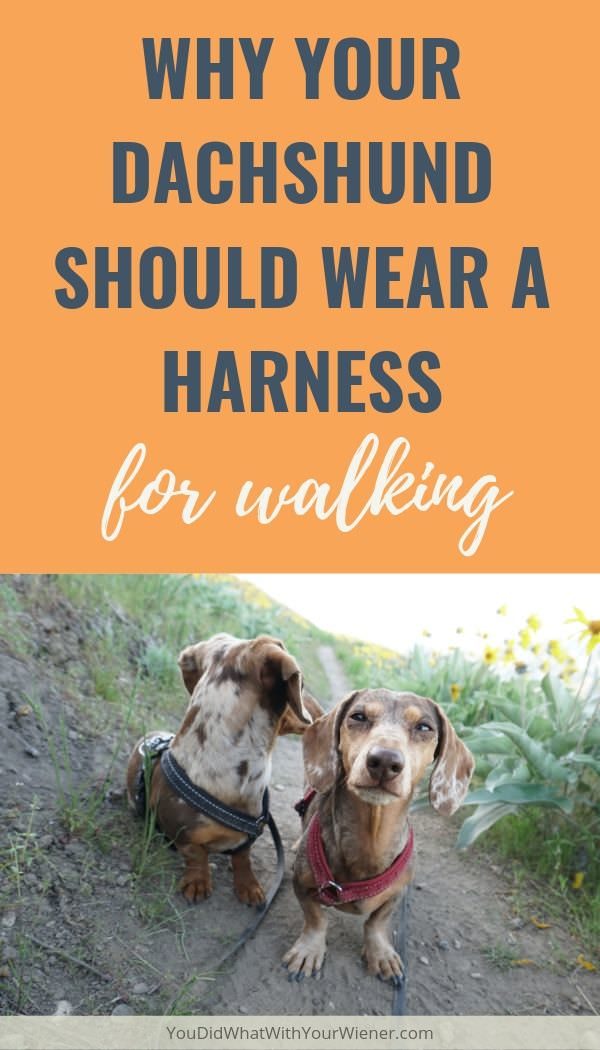

About the Author
Hi, I’m Jessica. I’ve been studying the Dachshund breed since 2007, owned 3 of my own, and shared in the lives of thousands of others through their owner’s stories. When I’m not sharing what I know on this blog, you can find me hiking, camping, and traveling with my adventurous wiener dogs.

Always follow your advice and what you are up to with your doxies!
Thank you
Just ordered the Vel Pro for Ollie! Thanks for the advice and recommendation.
Great. I hope you like it!
Never put a harness on a dachshund . Been breeding and showing and researching dachshunds since 1978. Do not put harnesses on dachshunds. You will create cervical pain bc of their complex fronts . They have chicken breast heats. A head harness is the proper gear. Also you loose total control of them and they won’t listen to you.
I’ve been researching Dachshunds and back/neck issues for over a decade and I don’t agree. But I appreciate you sharing your experience.
You’re also in the bussines of selling or promoting harnesses.
Am I? I don’t have a business selling harnesses. I have written articles about harnesses I have tested, use, and recommend. If one wants to try the ones I recommend then, yeah, they have to buy them. But no worries if not. It doesn’t make any difference to me.
It is interesting to hear your point of view. We have a Tweenie and often wonder if we should switch to a harness instead of the collar/leash. What is a head harness? Could you recommend a brand?
Have you had experience with a gentle leader/head halter for a doxie?
A little. I don’t recommend them. The leash attaches under the jaw and on a short dog that puts the leash at a very strange angle. Also, if your Dachshund did pull or run and something and get jerked by the leash, it would really twist their neck. Since Dachshunds are known to rupture disks in their neck and back, that would not be good.